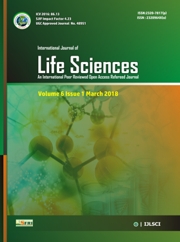RESEARCH ARTICLES
Volume 8 |Issue 2| March-April 2020 First published: 28 April 2020
Exploration of nutritional information in some honeys of commercial brands- and Apis dorsata in Vidarbha region of Maharashtra State in India
Paliwal Gopal1*, Paliwal Sunita2, Khandelwal Puja3 and Zade Varsha4
1and 2Centre for Bee Development, Nalwadi, Wardha, MS, India, 442
3Govt. Vidharbha Institute of Science & Humanities, Amravati, MS, India, 442 001
4Associate Professor, Govt. Vidharbha Institute of Science & Humanities, Amravati, MS, India, 442 001
*Corresponding Author: Dr. Gopal Paliwal Email: gopalpaliwal23@gmail.com
Abstract
Keywords:PreHoney, Apis dorsata, Apis mellifera, Nutritional Information, Vidarbha
Editor: Dr.Arvind Chavhan
Cite this article as:
Paliwal Gopal, Paliwal Sunita, Khandelwal Puja and Zade Varsha. Exploration of nutritional information in some honeys of commercial brands- and Apis dorsata in Vidarbha region of Maharashtra State in India, Int. Res. Journal of Science & Engineering, 2020, Volume 8 (2): 71-84.
References
1. Deininger DU and Sur M. Food safety in a globalizing world: opportunities and challenges for India”, South Asia Sustainable Development Department, World Bank, 2007.
2. Euromonitor, 2008, Packaged Food – India Report, London: Euromonitor International.
3. Kumar S and Jabir Ali et al. Regulatory Arrangements for Disclosure of Nutritional Information on Food Labels in India. In : 21st Annual IFAMA World Forum and Symposium on the Road to 2050: Sustainability as a Business Opportunity, Frankfurt, Germany during June, 2011; 20-23.
4. Murali D. 2006, Always check nutritional labels. The Hindu business line (Internet edition)
5. FAO, 2003, Assuring Food Safety and Quality: Guidelines for Strengthening National Food Control Systems”, FAO Food and Nutrition Paper 76, Food and Agriculture Organization of the United Nations and World Health Organization, Rome. ISSN 0254-4725.
6. Codex Alimentarius Commission. 2001. Revised Codex Standard for honey, Codex STAN 12–1981, Rev. 1 (1987), Rev., 2.
7. FSSAI (2011) the Food Safety and Standards Rule, 2011, Gazette if India, Part II, Section 3 (i).
8. Chataway HD. Determination of moisture in honey. Canad J Res., 1932, 6: 532-547.
9. Wedmore EB. The Accurate Determination of the Water Content of Honeys: Part I. Introduction and Results, 2015, Pages 197-206, Published online
10. Wakhale, D.M., Phadke, R.P., Pais, D.V.E. And Nair, S.K. (1996). Design for honey processing unit Part 2, Indian Bee J., 58: 5-9.
11. Acquarone, C., Buera, P. and Elizalde, B. (2007). Pattern of pH and electrical conductivity upon honey dilution as a complementary tool for discriminating geographical origin of honeys. Food Chemistry, 101, 695–703.
12. AGMARK (1984). Honey grading and Marking Rules.
13. Bogdanov, S. C. Lüllmann, P. Martin, W. Von Der Ohe, H. Russmann, B.L. Mossel, B. D’ Arcy, G.R. Vorwohl, L. Oddo, A.G. Sabatini, G.L. Marcazzan, R. Piro, C. Flamini, M. Morlot, J. Lheretier, R. Borneck, P. Marioleas, A. Tsigouri, J. Kerkvliet, A. Ortiz, T. Ivanov, P. Vit, P. Martin, (1999) Honey quality, methods of analysis and international regulatory standards: review of the work of the international honey commission Bee World, 80 (1999), pp. 61-69.
14. Paliwal SG. Studies on the sustainable apicultural biotechnology of rock honey bee, A. dorsata (F.) (Hymenoptera: Apidae), Ph. D. thesis submitted to RTM Nagpur university, 2008.
15. Fea´ S, X., Pires, J., Iglesias, A., Estevinho, M.L., (2010). Characterization of artisanal honey produced on the Northwest of Portugal by melissopalynological and physico-chemical data. Food Chem. Toxicol. 48, 3462–3470.
16. Vanhanen LP. Emmertz A, Savage GP. Mineral analysis of mono-floral New Zealand honey. Food Chem. 2011, 128, 236–240.
17. Boussaid A, Moncef C, Leila Rezig, Raoudha H, Francesco D, Giovanna F, Salem H. Physicochemical and bioactive properties of six honey samples from various floral origins from Tunisia, Arabian Journal of Chemistry, 2018, 11, 265-274.
18. EI-Bialee NM and Sorour MA. Effect of adulteration on honey properties. Int. J. Appl. Sci. Technol. 2011, 6. 122-133.
19. Food Product Standards and Food Additives, Amendment Regulations (2019).
20. Anklam EA. review of the analytical methods to determine the geographical and botanical origin of honey. Food Chemistry, 1998, 63, 549–562.
21. Azeredo LDC, Azeredo MAA, Souiza SR and Dutra VML. Protein contents and physicochemical properties in honey samples of A. mellifera of different origins. Food Chemistry, 2003, 80, 249–254.
22. Schäfer, MOV, Dietemann, CWW, Pirk P, Neumann RM, Crewe HR, Hepburn J, Tautz K Crailsheim. Individual versus social pathway to honeybee worker reproduction (Apis mellifera): pollen or jelly as protein source for oogenesis, J. Comp. Physiol. 2006, A, 192, pp. 761-768.
23. Subramanian R, Hebbar HU and Rastogi NK. Processing of honey: a review Int. J. Food Prop., 2007, 10 (1): 127-143.
24. EI-Sohaimy, SA, Masry SHD, Shehata MG. Physicochemical characteristics of honey from different origins, Annals of Agricultural Science, 2015, 60 (2), 279-287.
25. Iurlina MO and Fritz R. Characterization of microorganisms in Argentinean honeys from different sources. International Journal of Food Micribiology, 2005, 105, 297-304.
26. Almeida-Muradian, Ligia B. de, Klaus M. Stramm, Andreia Horita, Ortrud M. Barth, Alex da Silva de Freitas and Leticia M. Estevinho. Comparative study of the physicochemical and palynological characteristics of honey from Melipona subnitida and Apis mellifera, International Journal of Food Science and Technology, 2013, 48, 1698–1706.
27. White JW and Doner LW. Honey Composition and Properties: Beekeeping in the United States. Agriculture Handbook No. 335, 1980, pp. 82–91.
28. Buba FA, Gidado A Shugaba. Analysis of biochemical composition of honey samples from North-East Nigeria Biochem. Anal. Biochem., 2013, 2 (3) , p. 139.
29. Manzoor M, Shah GHN, Mathivanan V, Mir GM, Shahnawaz AD. Chemical analysis of honey of Apis cerana F. and A. mellifera from Plains of Jammu and Kashmiri and Tamil Nadu, Int. J. Agri. Sci. Res., 2013, 3 (4), pp. 139-146.
30. EL-Metwally AAE. Factors Affecting the Physical and Chemical Characteristics of Egyptian Beehoney. Ph. D. Thesis, Fac. Agric. Cairo Univ., 2015¸320p.
31. Rodriguez-Otero JL, Paseiro P, Simal J, Cepeda A. Mineral content of the honeys produced in Galicia (North-west Spain). Food Chem. 1994, 49, 169–171.
32. Puja K., Paliwal G. and Zade V. Physicochemical Composition of A. dorsata honey collected from the Vidarbha Region of Maharashtra State in India. Int J. Recent Sci Res., 2020, 11(02), pp. 37431-37437.

